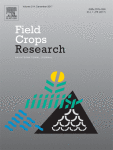Ver ítem
- xmlui.general.dspace_homeCentros Regionales y EEAsCentro Regional La Pampa - San LuisEEA AnguilArtículos científicosxmlui.ArtifactBrowser.ItemViewer.trail
- Inicio
- Centros Regionales y EEAs
- Centro Regional La Pampa - San Luis
- EEA Anguil
- Artículos científicos
- Ver ítem
Vetch-rye biculture is a sustainable alternative for enhanced nitrogen availability and low leaching losses in a no-till cover crop system
Resumen
The reliance of current farming systems on synthetic fertilizers caused concerns about their sustainability, and alternatives to supply nitrogen through biological processes have to be adapted to practical conditions. The present study compared a pure legume and legume-grass biculture as cover crops for sorghum in their supply of nitrogen (N) to the cash crop and their N leaching losses during fallow. A three-year field experiment under no-till with
[ver mas...]
The reliance of current farming systems on synthetic fertilizers caused concerns about their sustainability, and alternatives to supply nitrogen through biological processes have to be adapted to practical conditions. The present study compared a pure legume and legume-grass biculture as cover crops for sorghum in their supply of nitrogen (N) to the cash crop and their N leaching losses during fallow. A three-year field experiment under no-till with sorghum (Sorghum bicolor Moench.) as main crop and cover crop treatments (C- control = bare fallow; R-rye Secale cereale L.; V-vetch Vicia villosa sp dasycarpa; VR-vetch-rye biculture) was established with a completely randomized block design (four replicates) in semiarid central Argentina. Aerial biomass (AB) and N contents were determined for all crops. Soil moisture to 1 m and nitrate-N to 0.60 m depth were determined. Water use- and nitrogen use efficiencies (WUE and NUE) were calculated and biological nitrogen fixation (BNF) estimated. BNF depended on nitrate-N contents of the soils; highest values (11 and 10 g BNF m−2 for V and VR respectively) were reached at 1.3 g N m−2. Sorghum responded to higher N availability with an average of +299 and +512 g AB m−2 for V and VR compared to C, with higher WUE. The relationship between WUE and nitrate-N was positive with an optimum of 0.048 g N m−2 mm −1 where WUE reached a maximum of 4.9 g AB m−2 mm−1. Potential N losses by leaching were highest in control, while all cover crop treatments had lower losses. Our results support the hypothesis that a legume-grass biculture was more efficient in the trade-off between nitrogen provision to the cash crop and prevention of N losses by leaching. Although the amount of BNF was lower in the biculture than in pure vetch, it covered sorghum N requirements with less potential leaching losses even in high rainfall fallows.
[Cerrar]

Autor
Fuente
Field crops research 214 : 104-112. (December 2017)
Fecha
2017-12
ISSN
0378-4290
Formato
pdf
Tipo de documento
artículo
Palabras Claves
Derechos de acceso
Restringido
 Excepto donde se diga explicitamente, este item se publica bajo la siguiente descripción: Creative Commons Attribution-NonCommercial-ShareAlike 2.5 Unported (CC BY-NC-SA 2.5)
Excepto donde se diga explicitamente, este item se publica bajo la siguiente descripción: Creative Commons Attribution-NonCommercial-ShareAlike 2.5 Unported (CC BY-NC-SA 2.5)

